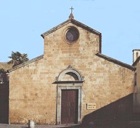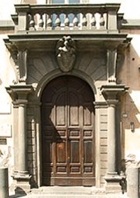

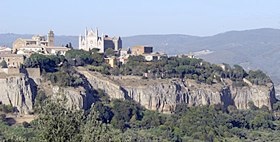
Duomo, with the Convento di San Francesco to the left
This walk starts in the Piazza del Duomo, which surrounds three sides of the Duomo.
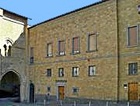
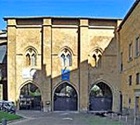
-
✴the Museo dell’ Opera del Duomo; and
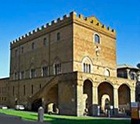
-
✴The ground floor loggia of Palazzo Soliano contains a number of interesting Roman remains found in the surrounding area.
-
✴The entrance in the loggia leads to the ground floor room of Palazzo Soliano, which houses the Museo Emilio Greco.
The earlier cathedral mentioned above was known as Santa Maria Episcopatus or Santa Maria Prisca, and it had a secondary dedication to St Brictius (San Brizio). There are a number of theories relating to the site of this church, which was demolished in 1297. Although it was formally the bishop's church, its day-to-day running was in the hands of the canons of the Cathedral Chapter, who also had their own church in the piazza that was dedicated to the Perugian saint, St Constantius (San Costanzo). This church was demolished in ca. 1290 to make way for the present Duomo (see below), and its foundations were discovered under the nave in 1955-6.
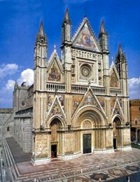
The Opera del Duomo, which was formed early in the 14th century to oversee the its construction and decoration, soon made its presence felt in the piazza:
-
✴It acquired in Palazzo Soliano in 1330 and housed a number of production facilities there.
-
✴It commissioned a clock (the earliest to be documented in Europe) for the tower at the north west corner of the piazza in 1347. In the following year, it commissioned a bronze automaton dressed as a site foreman to strike the hours and thereby regulate the working hours on the site. The medieval word for a construction site was "muricçio", which led to the recent appellation of the tower as the "Torre di Maurizio".
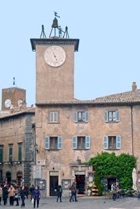
-
✴It also acquired properties on the west side of the piazza in 1359 that later provided the site for the Palazzo dell’ Opera del Duomo (see below).
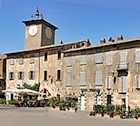
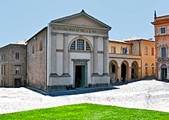
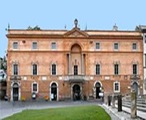
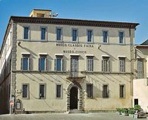
San Giacomo Maggiore Palazzo dell’ Opera del Duomo Palazzo Faina
The piazza took on its present appearance in the 19th century with:
-
✴church of San Giacomo Maggiore and the hospital behind it, at the west end of the south side;
-
✴the remodelling of the Palazzo dell’ Opera del Duomo, on the west side, opposite the facade of the Duomo; and
-
✴the construction of Palazzo Faina to the right of the Palazzo dell’ Opera del Duomo.
Palazzo Faina houses:
-
✴the Museo Civico; and
-
✴the Museo Claudio Faina.
The Parco delle Grotte, to the left of San Giacomo Maggiore, is laid out on land that used to form part of the hospital complex. It offers a lovely view of the Abbazia di SS Severo e Martirio below. A gate to the right of the terrace opens onto a short path to a series of grottoes that can be visited (Orvieto Underground).
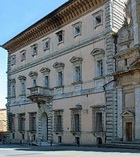
-
✴the church and convent of San Bernardino; and
-
✴Palazzo Crispo-Marsciano (illustrated here, with San Bernardo to the right of it).
The road to the left of San Bernardino, which led down to the ancient Porta Santa Maria (of which no trace survives), was not heavily used by the 16th century. The Commune allowed the nuns to close it in 1562.
It is possible to take a detour from this point to the site of the Etruscan necropolis and temple of Cannicella by following part of a trail around Orvieto known as the Anello della Rupe (ring around the cliff). However, you can alternatively visit the necropolis as part of Walk IV. Indeed, this was the only option at April 2012, when the point of access here was closed for maintenance.
If the access is open and you decide to do the visit now, turn right along the left side of Palazzo Crispo Marsciano and take the spiral steps down to the path. Continue along it and take the right fork down. Fork left at each of the next two T-junctions (still walking downhill), following signs to B&B Cannicella.
✴A left turn, still signed to B&B Cannicella, leads past the the only visible evidence of the excavations of the necropolis (on the left). (The B&B is just beyond, at the end of the lane. There is a large dog in residence, so be careful not to walk uninvited through its gates.)
✴Walk back up the lane and turn left to continue downhill to the site of the temple.
You can retrace your steps back up the cliff to continue Walk I. However, an easier (albeit longer) route is possible. Turn left along the second side of the site of the temple and continue to the junction with the Strada Fontana del Lione. Turn left along Strada Fontana del Lione to Porta Postierla and walk along Via Postierla. This becomes Via Soliano and takes you back to Palazzo Crispo Marsciano.
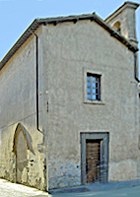
Turn left at Via Scalette and cross Piazza del Duomo: other buildings that, like Santa Lucia, belonged to the canons of the Duomo are now on your right. Turn right along Via del Duomo, which is the ancient thoroughfare that linked the ecclesiastical centre of Orvieto to the two civic centres:
-
✴Piazza del Comune (now della Repubblica - see Walk II); and
-
✴Piazza del Popolo (see Walk III).
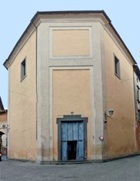
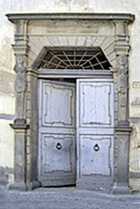
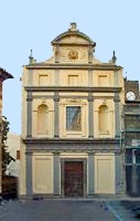
-
✴the Chiesa degli Scalzi, illustrated here; and
-
✴the Chiesa dell’ Annunziata, to the right of it.
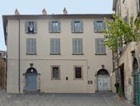
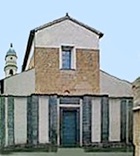
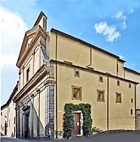
-
✴The Chiesa del Buon Gesù (illustrated here) is opposite, in Piazza Clementini.
-
✴A short detour to the right along Via Alberici leads to Palazzo Saracinelli (at number 11 on the right).
Retrace your steps to the Chiesa del Buon Gesù and continue along Via Ghibellina passing a number of disused Franciscan buildings on the right:
-
✴the ex-church of Sant’ Onofrio, which now forms part of the Monastero del Buon Gesù;
-
✴the ex-church of Santa Chiara; (just past number 10); and
-
✴the ex-church and hospice of Sant’ Anna dei Padri Riformati (at number 23).
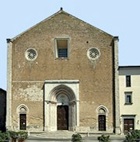
Return to Piazza Febei and take Via Lorenzo Maitani alongside the side of San Francesco. (This part of the walk is described in the page on the church and convent). The road leads into a shady square and the Ristorante al San Francesco, which occupies part of the ex-convent.
It is possible to follow Via Bonaventura Cerretti as it winds down to the left and, if the gate on the left is open, to take the unmade road (with stunning views) passing the grottoes. This takes you back to the Parco delle Grotte (the release for the gate is on the right) and into Piazza del Duomo.
Alternatively, retrace your steps and turn right into Via Lorenzo Maitani, which leads to the Piazza del Duomo and the end of the walk.
Return to Walks Around Orvieto.
